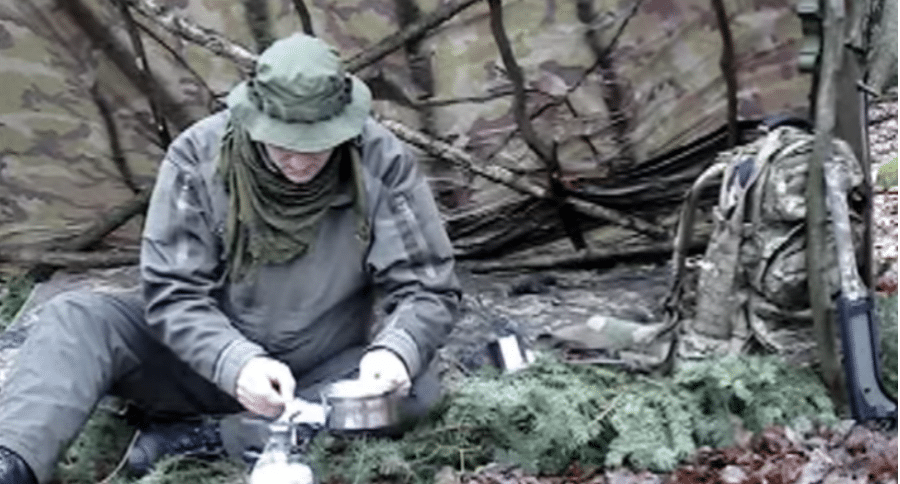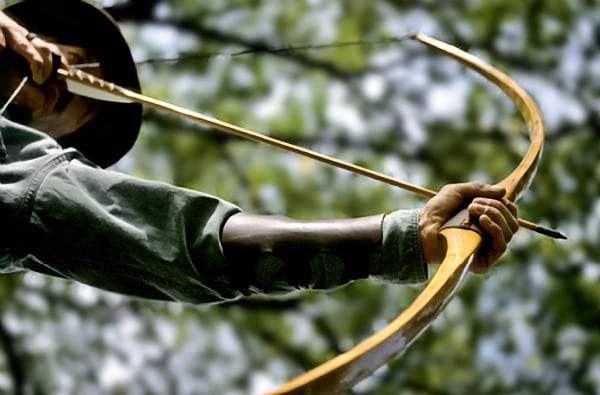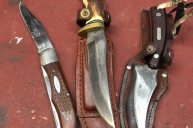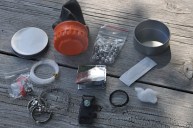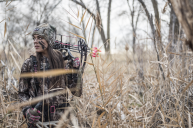If you're in a survival situation, whether it's a post-apocalyptic scenario or you're lost in the wilderness, you'll need survival weapons of some sort to get you through.
When the term "survival weapons" comes up most of us tend to think of a SHTF, post-apocalyptic world where we're fighting off hordes of flesh-eating zombies or other humans with bad intentions. But in reality, survival weaponry will more likely be used to procure food from the wild and protect yourself from dangerous critters not of the zombie kind.
But we'll take a look at both scenarios and the pros and cons of the weapons you might choose to carry on your person or in your bug-out bag.
We won't be talking about some of the more exotic survival weapons like throwing stars, war hammers, nailed baseball bats, or homemade survival weapons like flamethrowers, blowguns, homemade shotguns and the like. Those are, in my opinion, lethal weapons really only found on television shows. While they are undoubtedly effective for battling zombies and human scavengers, I think they're designed to be more badass-looking than practical.
Firearms
Firearms are often the first and most obvious choice for many people when selecting a survival tool. Guns are widely available, relatively easily procured and easily used and carried. They also provide a level of security against dangerous animals and would-be human assailants that is hard to beat.
They are able to be quickly deployed and, in the case of handguns, can effectively be used with one hand if necessary. For those of us who conceal carry, carrying a handgun is a part of daily existence. You'll have to decide which caliber and which style of handgun you prefer—revolver or semi automatic—based on a number of considerations.
For example, if you run the risk of running into a grizzly bear or a pack of wolves, you may want something more powerful than the .22 you might choose to procure small game. Perhaps two guns would be a better option. You could carry a large-caliber handgun for personal protection and a rifle like Henry's AR-7 Survival Rifle for game procurement.
I'd suggest a .22 rifle as an all around wilderness or urban survival gun, as it's lightweight, reliable, easy to use and clean, and the ammunition it uses is cheap, easily affordable and small. You can kill deer and larger game with a .22. Its report isn't too loud, which could be a disadvantage if you're trying to signal someone. I'd also suggest carrying a larger caliber handgun, something akin to a .357 Magnum or .44 Magnum, for self-defense and peace of mind.
Of course, you should also carry an adequate supply of ammunition, which brings up another disadvantage associated with firearms. Once you run out of ammo, they're basically useless, with the possible exception of scaring off would-be human attackers.
Knives
A knife should be considered a must-have survival tool. Carrying at least one knife, and probably more, is a given in any survival situation. Knives are the single most versatile "multitool" you can have. With a knife you can make other tools and DIY weapons, build a shelter, build a fire, procure food, make clothing, open a can of beans and defend yourself. You can even just whittle away the time when you're bored waiting for the rain to stop.
There are many good survival knives on the market today. I won't go into all of the attributes you should look for when choosing a survival knife. I will, however, point you to this article (click here) on the subject.
A mid-sized fixed blade knife and a folding pocket knife are the knife style you should be carrying. Folding knives aren't as sturdy as fixed blade knives, but their compactness makes them easy to stow away until needed. Knives are generally lightweight enough that you can easily carry more than one.
You'll also probably want to carry a sharpening stone with you in order to keep your knife edge keen. The sheath you choose for your fixed blade knife can also be a source of additional survival tools. For instance, you can have a knife sheath made that'll also hold a fire steel, a whetstone, a compass and any other tidbits you might find useful in a survival situation. Bushcraft knives and their attendant multipurpose sheaths are a great option to consider.
Hatchet
The benefit of carrying a hatchet is that it's both a functional tool and a self-defense weapon. A hatchet or stout tomahawk can be used to chop wood or small trees, carve a spear, clear brush and more. It can also put a little more distance between you and a would-be attacker or dangerous animal in close quarters should you need to employ it in that regard.
In a survival scenario, I would definitely want to carry a knife and a hatchet. If you're able, you should also consider carrying a small file with you to touch up the edge of your hatchet when necessary.
If you can comfortably carry or stow an actual, full-length ax, all the better. The weight of carrying such a tool may be prohibitive, however. You can do a lot more with an ax that might unduly tax a hatchet, but a good, sharp hatchet is a great choice. It's relatively lightweight and can perform multiple tasks with ease.
Don't go with a cheap, hardware store hatchet. Choose a hatchet the has a wooden handle that the head fits into. Should the handle break on an all-metal or all-composite hatchet—where the head and haft are one unit—you're pretty well screwed. If the haft should break on a wood-handled hatchet, you can always carve another handle and insert it into the head's eye (opening).
If you can afford it, go with a high-quality hatchet like a Gransfors Bruks or a Hults Bruk Almike Hatchet. They're pricey, but they'll last a lifetime and have extremely good steel that won't let you down. Save your money and buy a quality hatchet.
Slingshot
A slingshot is a great survival weapon. It's small, lightweight and it can shoot almost any rock or pebble you can find on the ground. You will, however, probably want to carry a supply of round steel balls or marbles to use for ammunition. But once you run out, you have an endless ammunition all around you.
It isn't too difficult to become skilled and accurate when firing a slingshot. You can effectively kill small game and birds with this weapon.
In my opinion, a slingshot is one of the best survival weapons you can have. You should always carry an extra set of surgical rubber bands, though.
A sling, on the other hand, is comprised of a couple of lengths of string, rope or leather with a pouch tied in between them. A projectile such as a stone is placed in the pouch. The sling is then swung or twirled in an arc before releasing one of the lines, and thus firing the projectile toward its intended target.
Slings can be purchased but are easily crafted. They can be highly effective as both a combat weapon and a hunting weapon.The trouble with them, in my opinion, is that they require an inordinate amount of skill to use effectively. Go with the slingshot.
Bow and arrows
If you have the skill, you can make a bow and arrows in the wild. You can also carry a takedown bow in your pack or bug-out bag. Becoming an accurate archer requires some level of skill and the ability to get close to game, but if you can do it, a bow and arrow can be a good choice as a survival weapon.
The problem with a bow and arrow for the inexperienced survivalist is that it's relatively large, takes time and strength to fire accurately, and requires you to be a very good hunter if you're to procure game consistently.
I love bowhunting, which is part of the reason I include it on this list of survival weapons. I personally have a takedown bow in my survival kit.
And again, if you have the skill, you can fashion replacement arrows and points from the forest if need be. Frankly, it's not a bad skill to develop. But for most non-bowhunters, I'd suggest avoiding including a bow and arrows in your survival kit.
Pepper spray/bear spray
Pepper spray and, more appropriately, bear spray, is purely a defensive weapon. You should always carry bear spray if there's a chance you could find yourself in a survival situation where bears are prevalent. Pepper spray is also a good defense weapon for use against human attackers in a SHTF situation.
They're both lightweight and easy to carry. In an urban situation, though, pepper spray can be carried in your hand and discharged in an instant. Bear spray comes in a larger canister and is carried on the belt or side of a backpack. It covers a wider range than pepper spray—up to 30 feet or so—and in most cases is an effective deterrent in thwarting a bear attack.
The last thing you want to have happen to you in a survival situation is having a bear maul you, so carry bear spray. It has but one purpose, but that purpose is mighty important.
Conclusion
These are the most common, easily acquired and easily carried survival weapons available to most people. The learning curve isn't especially great with any of these items, although it would be wise to train with whatever weapon you choose on a regular basis.
You should carry at least one of these, and probably more, if there's any chance of you being caught in a desperate situation in the wilderness or in an urban setting.
Like what you see here? Experience more articles and photographs about the great outdoors at the Facebook page, Stumpjack Outdoors.
NEXT: SURVIVAL GURU RAY MEARS SHOWS HOW TO MAKE THE BEST CORDAGE FROM NETTLES
WATCH
